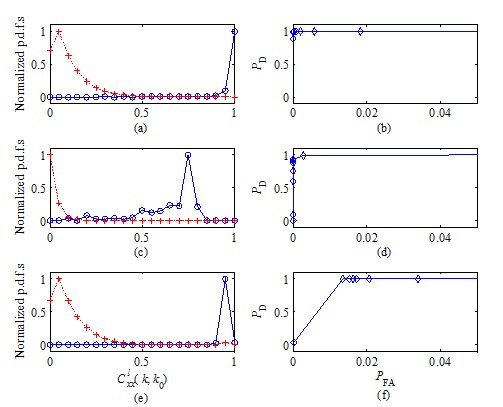SINCE Goodman defined the coherence function between two wide-sense stationary random processes, it has already been widely studied due to its wide applications, such as signal detection, signal estimation and system identification.
Unlike the coherence function defined before, researchers from the Institute of Acoustics, Chinese Academy of Sciences proposed a temporal coherence function (T-CF) and a spectral coherence function (S-CF) for only one random process to detect howling components and transient noise components, respectively. This is based on the fact that the independence assumption of spectral components is not necessarily true for all types of signals. For example, the coherence times of howling components are nearly infinite. Although numerous experimental results have verified the validity of the T-CF and the S-CF in detecting the howling and/or the transient noise components, their relationship is still uncovered. Moreover, their applications are not well discussed.
Here, the T-CF and the S-CF are treated in a unified way, which is referred as a generalized auto-spectral coherence function (GAS-CF). Notice should be given that the GAS-CF measures the coherence of different frequency components for only one random process, which is unlike the FFT-CF, the MVDR-CF and the CCA-CF that measure the cross-coherence of two random processes. Furthermore, statistical properties of the GAS-CF are studied in detail. Finally, some applications in signal detection are discussed and simulations are given to show the validity of the GAS-CF.
The GAS-CF can be estimated by:

where  and
and  are N-point FFTs of
are N-point FFTs of  and
and  ,with
,with  and
and 
Some simulation examples are given to show the validity of the proposed GAS-CF in signal detection. The results are plotted in Fig. 1.

Fig. 1 Experimental Results of the proposed GAS-CF in detecting (a) and (b): howling components; (c) and (d): transient noise components; (e) and (f): chirp signal (Image by Zheng).
These results reveal that the proposed GAS-CF can be applied to detect signal in a simple way. Because the GAS-CF is a normalized measure of similarity between two spectra of the input signal, it is not difficult to determine the detection threshold in most cases. Wherein, the main reason is that the value of the GAS-CF is not influenced by the relative value of the power spectral density of the input signal.
This research was supported by NSFC (National Science Fund of China) under Grant Nos. 61201403 and 61302126. This research was also supported in part by the tri-networks integration under No. KGZD-EW-103-5(3).
Journal References:
C. Zheng, H. Yang, and X. Li. On generalized auto-spectral coherence function and its applications to signal detection. IEEE Signal Processing Letters (vol. 21, no. 5, pp. 559-563, May 2014).
Contact:
Zheng Chengshi, Communication Acoustics Laboratory, Institute of Acoustics, Chinese Academy of Sciences, Beijing 100190, China. E-mail: cszheng@mail.ioa.ac.cn





 and
and 
 and
and  ,with
,with  and
and 